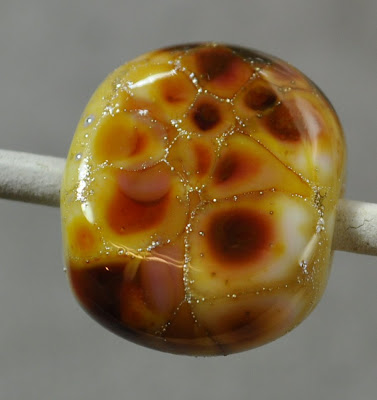
Yet another burst of pinkness - this one seems a bit more intense - possibly because of having some opaques.
The working notes say:
Blend - Opaque/TransparentI tell ya - having these notes with the frit, as in the sample packs - is just one of the best things about these frit blends. Being armed with this knowledge can save you oodles of frustration.
... complex mix of several gold-pink and salmon tones ... . When silver foil is incorporated, yellow gold tones emerge. ... can be fussy - and prone to devitrification ... don't expose to frequent heating and coooling ... .
So - devits - we'll stick to designs that don't require heating and cooling and heating.
First up - a simple clear spacer, rolled in frit. Did not go back in the flame after melting in the frit.
 Next up - same idea, on white.
Next up - same idea, on white.
Now, let's test this silver foil idea. White bead, roll in silver, melt in, add frit, mash. Love the way the silver bead up and pops up between the frit.

Next, same again, but encased. White bead, roll in foil, melt in, frit, clear, melt down. Kinds looks like a half-eaten mango.
 All righty then - let's go crazy. Do you really want to know all the steps for this? You do? OK ...
All righty then - let's go crazy. Do you really want to know all the steps for this? You do? OK ...Periwinkle base bead
- CiM Lapis and Double Helix Triton lines
- Silver foil, melt in
- frit
- encase
- add ends in Triton
- mash
- push ridges into the glass
- encase it again, filling in the ridges, but hoping to retain the look of texture. Sorta worked.
- Add wings - which are clear and triton
- Mash wings, for shape and ruffles
- Dots - Triton
- Reduce.
I didn't have any trouble with this frit - but knowing that there are gold-pinks in it, subject to de-vitrifying, I significantly changed the way I worked on this.
Quite a nice blend - and I think I can respect it better for being a bit of a challenge. Which is not to say that I don't enjoy the pushover blends too!
This bead is absolutely fantastic!!
ReplyDeleteJohanna